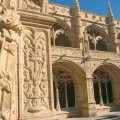The Mosteiro dos Jerónimos is one of the most emblematic monuments of Lisbon and Portuguese history.
The Mosteiro dos Jerónimos, or Hieronymite Monastery, is one of Lisbon's most emblematic monuments. Built in the Belém district, it is a masterpiece of Manueline architecture, a Gothic style characterized by the use of maritime and plant motifs, symbolizing the age of Portuguese discovery. The monastery was commissioned by King Manuel I in the early 16th century to commemorate the triumphant return of Vasco da Gama from India. Built on the site of a former church, the monastery was entrusted to the Order of St. Jerome, hence its name. This religious order's mission was to provide spiritual guidance to sailors and pray for the king's soul. It took a hundred years to complete, mobilizing craftsmen from all over the world, under the direction of architects Diogo de Boitaca, then João de Castilho. The monastery houses the tombs of such illustrious figures as Vasco da Gama, the poet Luís de Camões and the great writer Fernando Pessoa. In 1983, it was declared a UNESCO World Heritage Site.
The church leads to the cloister, amasterpiece of Manuelinearchitecture . Carved stone reigns supreme: not a column, a capital, a pillar or an arch is free from motifs, interlacing, variations on ornamental foliage and the symbolism of circles, punctuated by different gargoyles. The small fountain, placed in one side of the cloister, was previously in the center. It depicts a tamed lion kneeling on a prie-Dieu..
Did you know? This review was written by our professional authors.
Book the Best Activities with Get Your Guide
Members' reviews on MOSTEIRO DOS JERÓNIMOS
The ratings and reviews below reflect the subjective opinions of members and not the opinion of The Little Witty.



Find unique Stay Offers with our Partners











